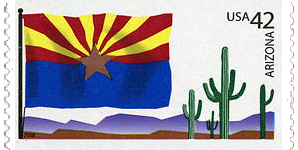 US Postage Stamps
// Philatelic Project
// The Federal States
US Postage Stamps
// Philatelic Project
// The Federal States
Capitals of the Federal States
 US Postage Stamps
// Philatelic Project
// The Federal States
US Postage Stamps
// Philatelic Project
// The Federal States
Capitals of the Federal States

|

|
|
#4277 // June 14, 2008
(self-adhesive coil definitive) Flags of Our Nation Series Arizona State Flag, and Saguaro cacti |
Flag of the City of Phoenix,
capital of the State of Arizona The name of the city originates from a suggestion of Lord Phillip Darrell Duppa (* 1832, † 1892), inasmuch as the new town would spring from the ruins of the ancient Hohokam advanced civilisation that dated back to about 600 CE. |
|
City, Elevation,
and Coordinates |
County,
US Region |
Waters
US National Historic Landmark |
|
Phoenix, AZ
1,086 ft [331 m] 33°27' N 112°04' W |
Maricopa County
Southwest |
Salt River
Pueblo Grande Ruin & Irrigation Sites |
|
Land Area
rounded mi2 [km2] |
Population
(census 2010) |
Population Density
per mi2 [km2] of land area |
| 517 [1.339] | 1,445,632 | 2,796 [1.080] |
| History Timeline | |
| Between 600 CE and 1450 CE the prehistoric Hohokam Indian people settled in the area of present-day Phoenix. They cultivated the desert by developing an irrigation system along the Salt and Gila Rivers that allowed them to plant crops and establish permanent villages. These irrigation canals are directly responsible for the settlement of Phoenix. | |
| 1867 | Jack Swilling (* 1830, † 1878), an veteran cavalryman of the Confederate Army, rebuilt some of the abandoned Hohokam canals to harvest water from the Salt River to irrigate crops to sell to miners at the Vulture Mine in Wickenburg and the US Cavalry stationed at Fort McDowell. |
| 1868 |
On May 4, the settlement established by Jack Swilling officially was recognized when the Yavapai County Board of Supervisors, which at the time encompassed present-day Phoenix, formed an election precinct here.
On June 15, a post office was established with Jack Swilling as postmaster. The town was first called Pumpkinville, due to the large pumpkins that flourished in fields along the canals. Later it was called Swilling's Mill, Helling Mill, Mill City, and years later finally East Phoenix. |
| 1881 | On May 3, incorporated as a city. |
| 1912 | On February 4, Phoenix became Arizona's state capital. |

|

|
|
Paintings depicting the Hohokam Indians' irrigation canals (600 CE - 1450 CE)
© Courtesy by Arizona Historical Society |
|

|
| Area of settlement (light yellow dyed) of the Hohokam Indian people in Central Arizona. The Hohokam disappeared for unknown reasons from their villages near the Salt and Gila Rivers in 1450 CE. Their descendants survive as members of the Tohono O'odham Nation. |
![]()
